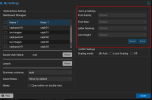Hi everybody.
Does anyone has maybe some fixes Tipps for the Serial Terminal for VM's (Qemu), like Ubuntu/Debian etc?
Because:
-> Serial Terminal on LXC Containers is pretty perfect, you can resize windows etc, everything is perfect...
-> Serial Terminal on VM's is horrible, you can resize either but most of the times something start to glitch... If you don't resize and stay with the default (small) Windows, its works well for a quite time, but at some point it fucks up too and you have to restart the console xD
It starts to nerv me, basically it never gotten better since PVE6 (i dont know PVE5 and before xD).
It nerved already since forever on Opnsense/PFsense VM's, but now i have a situation where i need to work over the Serial Terminal with an Ubuntu 24.04 VM.
Maybe someone knows some tunings etc...
Cheers
Does anyone has maybe some fixes Tipps for the Serial Terminal for VM's (Qemu), like Ubuntu/Debian etc?
Because:
-> Serial Terminal on LXC Containers is pretty perfect, you can resize windows etc, everything is perfect...
-> Serial Terminal on VM's is horrible, you can resize either but most of the times something start to glitch... If you don't resize and stay with the default (small) Windows, its works well for a quite time, but at some point it fucks up too and you have to restart the console xD
It starts to nerv me, basically it never gotten better since PVE6 (i dont know PVE5 and before xD).
It nerved already since forever on Opnsense/PFsense VM's, but now i have a situation where i need to work over the Serial Terminal with an Ubuntu 24.04 VM.
Maybe someone knows some tunings etc...
Cheers


